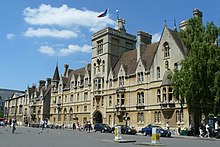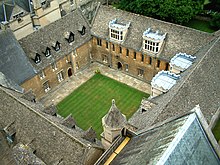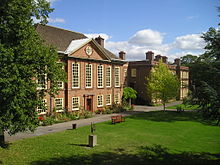The university is made up of a variety of institutions, including 38 constituent colleges and a full range of academic departments which are organised into four divisions. All the colleges are self-governing institutions as part of the university, each controlling its own membership and with its own internal structure and activities. Being a city university, it does not have a main campus; instead, all the buildings and facilities are scattered throughout the city centre. Most undergraduate teaching at Oxford is organised around weekly tutorials at the self-governing colleges and halls, supported by classes, lectures and laboratory work provided by university faculties and departments.
Oxford is the home of several notable scholarships, including the Clarendon Scholarship which was launched in 2001 and theRhodes Scholarship which has brought graduate students to study at the university for more than a century. The university operates the largest university press in the world[ and the largest academic library system in Britain. Oxford has educated many notable alumni, including 27 Nobel laureates, 26 Prime Ministers of the United Kingdom, and many heads of state from around the world.
Contents
History
See also: Timeline of Oxford
Founding
The University of Oxford has no known foundation date.Teaching at Oxford existed in some form as early as 1096, but it is unclear when a university came into being. It grew quickly in 1167 when English students returned from the University of Paris. The historianGerald of Wales lectured to such scholars in 1188 and the first known foreign scholar, Emo of Friesland, arrived in 1190. The head of the university was named a chancellor from at least 1201 and the masters were recognised as a universitas or corporation in 1231. The university was granted a royal charter in 1248 during the reign of King Henry III.
After disputes between students and Oxford townsfolk in 1209, some academics fled from the violence to Cambridge, later forming theUniversity of Cambridge.
The students associated together on the basis of geographical origins, into two "nations", representing the North (Northern or Boreales, which included the English people north of the River Trent and the Scots) and the South (Southern or Australes, which included English people south of the Trent, the Irish and the Welsh). In later centuries, geographical origins continued to influence many students' affiliations when membership of a college or hall became customary in Oxford. In addition to this, members of many religious orders, including Dominicans,Franciscans, Carmelites and Augustinians, settled in Oxford in the mid-13th century, gained influence and maintained houses or halls for students. At about the same time, private benefactors established colleges to serve as self-contained scholarly communities. Among the earliest such founders were William of Durham, who in 1249 endowed University College, and John Balliol, father of a future King of Scots; Balliol College bears his name.Another founder, Walter de Merton, a Lord Chancellor of England and afterwards Bishop of Rochester, devised a series of regulations for college life; Merton College thereby became the model for such establishments at Oxford, as well as at the University of Cambridge. Thereafter, an increasing number of students forsook living in halls and religious houses in favour of living in colleges.
In 1333–34, an attempt by some dissatisfied Oxford scholars to found a new university at Stamford, Lincolnshire was blocked by the universities of Oxford and Cambridge petitioning King Edward III.Thereafter, until the 1820s, no new universities were allowed to be founded in England, even in London; thus, Oxford and Cambridge had a duopoly, which was unusual in western European countries.
Renaissance period
The new learning of the Renaissance greatly influenced Oxford from the late 15th century onwards. Among university scholars of the period were William Grocyn, who contributed to the revival of Greek language studies, and John Colet, the noted biblical scholar.
With the Reformation and the breaking of ties with the Roman Catholic Church, recusant scholars from Oxford fled to continental Europe, settling especially at the University of Douai. The method of teaching at Oxford was transformed from the medieval scholastic methodto Renaissance education, although institutions associated with the university suffered losses of land and revenues. As a centre of learning and scholarship, Oxford's reputation declined in the Age of Enlightenment; enrolments fell and teaching was neglected.
In 1636, Chancellor William Laud, Archbishop of Canterbury, codified the university's statutes. These, to a large extent, remained its governing regulations until the mid-19th century. Laud was also responsible for the granting of a charter securing privileges for theUniversity Press, and he made significant contributions to the Bodleian Library, the main library of the university. From the inception of theChurch of England until 1866, membership of the church was a requirement to receive the B.A. degree from Oxford, and "dissenters" were only permitted to receive the M.A. in 1871.
The university was a centre of the Royalist party during the English Civil War (1642–1649), while the town favoured the opposingParliamentarian cause. From the mid-18th century onwards, however, the University of Oxford took little part in political conflicts.
Wadham College, founded in 1610, was the undergraduate college of Sir Christopher Wren. Wren was part of a brilliant group of experimental scientists at Oxford in the 1650s, the Oxford Philosophical Club, which included Robert Boyle and Robert Hooke. This group held regular meetings at Wadham under the guidance of the College Warden, John Wilkins, and the group formed the nucleus which went on to found the Royal Society.
Modern period
The mid-19th century saw the impact of the Oxford Movement (1833–1845), led among others by the future Cardinal Newman. The influence of the reformed model of German university reached Oxford via key scholars such as Edward Bouverie Pusey, Benjamin Jowettand Max Müller.
The system of separate honour schools for different subjects began in 1802, with Mathematics and Literae Humaniores. Schools forNatural Sciences and Law, and Modern History were added in 1853.By 1872, the latter was split into Jurisprudence and Modern History. Theology became the sixth honour school. In addition to these B.A. Honours degrees, the postgraduate Bachelor of Civil Law (B.C.L.) was, and still is, offered.
Administrative reforms during the 19th century included the replacement of oral examinations with written entrance tests, greater tolerance for religious dissent, and the establishment of four women's colleges. 20th-century Privy Council decisions (e.g. the abolition of compulsory daily worship, dissociation of the Regius Professorship of Hebrew from clerical status, diversion of colleges' theological bequests to other purposes) loosened the link with traditional belief and practice. Furthermore, although the university's emphasis traditionally had been on classical knowledge, its curriculum expanded in the course of the 19th century to encompass scientific and medical studies. Knowledge of Ancient Greekwas required for admission until 1920, and Latin until 1960.
The University of Oxford began to award doctorates in the first third of the 20th century. The first Oxford DPhil in mathematics was awarded in 1921.
At the start of 1914 the university housed approximately three thousand undergraduates and about 100 postgraduate students. The First World War saw many undergraduates and fellows join the armed forces. By 1918 virtually all fellows were in uniform and the student population in residence was reduced to 12 per cent.The University Roll of Service records that, in total, 14,792 members of the university served in the war, with 2,716 (18.36 per cent) killed. During the war years the deserted university buildings became hospitals, cadet schools and military training camps.
The mid-20th century saw many distinguished continental scholars, displaced by Nazism and communism, relocating to Oxford.
The list of distinguished scholars at the University of Oxford is long and includes many who have made major contributions to British politics, the sciences, medicine, and literature. More than 50 Nobel laureates and more than 50 world leaders have been affiliated with the University of Oxford.
Women's education
The university passed a statute in 1875 allowing its delegates to create examinations for women at roughly undergraduate level. The first four women's colleges were established due to the activism of the Association for Promoting the Higher Education of Women (AEW).Lady Margaret Hall (1878) was followed by Somerville College in 1879; the first 21 students from Somerville and Lady Margaret Hall attended lectures in rooms above an Oxford baker's shop.The first two colleges for women were followed by St Hugh's (1886),St Hilda's (1893)and St Anne's College (1952). In the early 20th century, Oxford and Cambridge were widely perceived to be bastions of male privilege,however the integration of women into Oxford moved forwards during the First World War. In 1916 women were admitted as medical students on a par with men, and in 1917 the university accepted financial responsibility for women's examinations.On 7 October 1920 women became eligible for admission as full members of the university and were given the right to take degrees.In 1927 the university's dons created a quota that limited the number of female students to a quarter that of men, a ruling which was not abolished until 1957.However, before the 1970s all Oxford colleges were for men or women only, so that the number of women was limited by the capacity of the women's colleges to admit students. It was not until 1959 that the women's colleges were given full collegiate status.
In 1974, Brasenose, Jesus, Wadham, Hertford and St Catherine's became the first previously all-male colleges to admit women.
In 2008, the last single-sex college, St Hilda's, admitted its first men, so that all colleges are now co-residential. By 1988, 40% of undergraduates at Oxford were female; the ratio was about 46%:54% in men's favour for the 2012 undergraduate admission.
The detective novel Gaudy Night by Dorothy L. Sayers, herself one of the first women to gain an academic degree from Oxford, is largely set in a (fictional) women's college at Oxford, and the issue of women's education is central to its plot.







No comments:
Post a Comment